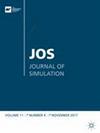模拟COVID-19的症状前传染性
IF 1.3
4区 工程技术
Q4 COMPUTER SCIENCE, INTERDISCIPLINARY APPLICATIONS
引用次数: 2
摘要
本文考虑的是对著名的连续仿真室模型SEIR的扩展。两种模型都可以拟合到实际数据中,因为它们包含了可以从数据中估计出来的参数。SEPIR部署了一个额外的症状前感染室,在SEIR中没有建模,但已知在COVID-19中存在。这个阶段也可以适用于数据。我们专注于如何使SEPIR适应第一波COVID。SEIR和SEPIR以及现有的SEIR模型都假设了一个参数固定的均匀混合种群。此外,两者都不包括针对病毒部署的动态变化控制策略。如果任何一个模型要代表的不仅仅是一波流行病,那么模型的参数就必须是时间相关的。鉴于此,我们还说明如何计算繁殖数量以调查流行病的长期总体结果。本文章由计算机程序翻译,如有差异,请以英文原文为准。
Modelling presymptomatic infectiousness in COVID-19
This paper considers SEPIR, an extension of the well-known SEIR continuous simulation compartment model. Both models can be fitted to real data as they include parameters that can be estimated from the data. SEPIR deploys an additional presymptomatic infectious compartment, not modelled in SEIR but known to exist in COVID-19. This stage can also be fitted to data. We focus on how to fit SEPIR to a first wave of COVID. Both SEIR and SEPIR and the existing SEIR models assume a homogeneous mixing population with parameters fixed. Moreover, neither includes dynamically varying control strategies deployed against the virus. If either model is to represent more than just a single wave of the epidemic, then the parameters of the model would have to be time dependent. In view of this, we also show how reproduction numbers can be calculated to investigate the long-term overall outcome of an epidemic.
求助全文
通过发布文献求助,成功后即可免费获取论文全文。
去求助
来源期刊

Journal of Simulation
COMPUTER SCIENCE, INTERDISCIPLINARY APPLICATIONS-OPERATIONS RESEARCH & MANAGEMENT SCIENCE
CiteScore
5.70
自引率
16.00%
发文量
42
期刊介绍:
Journal of Simulation (JOS) aims to publish both articles and technical notes from researchers and practitioners active in the field of simulation. In JOS, the field of simulation includes the techniques, tools, methods and technologies of the application and the use of discrete-event simulation, agent-based modelling and system dynamics.
 求助内容:
求助内容: 应助结果提醒方式:
应助结果提醒方式:


